springboot的简单了解与使用
Posted 那一夜
tags:
篇首语:本文由小常识网(cha138.com)小编为大家整理,主要介绍了springboot的简单了解与使用相关的知识,希望对你有一定的参考价值。
1. Spring Boot
1.1. 什么是Spring Boot

1.2. Spring Boot的优缺点
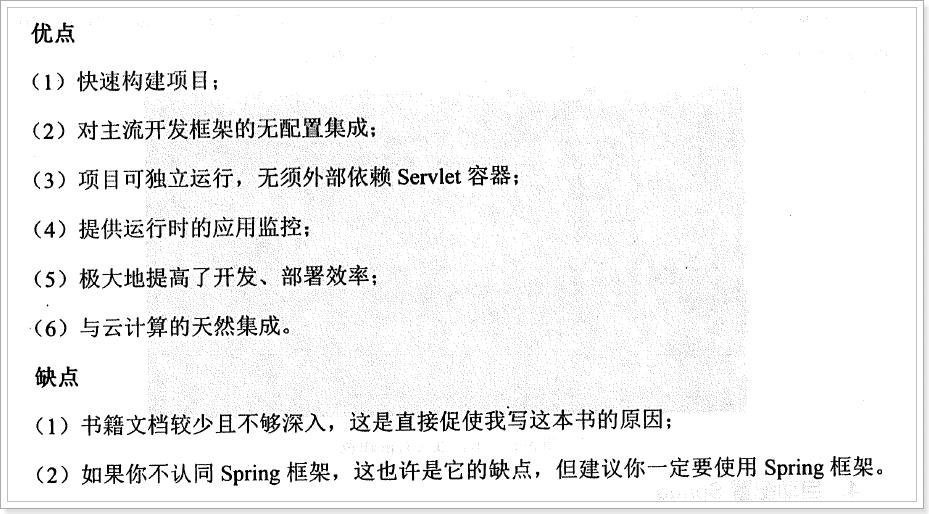
1.3. 快速入门
1.3.1. 设置spring boot的parent
<parent>
<groupId>org.springframework.boot</groupId>
<artifactId>spring-boot-starter-parent</artifactId>
<version>1.5.2.RELEASE</version>
</parent>
说明:Spring boot的项目必须要将parent设置为spring boot的parent,该parent包含了大量默认的配置,大大简化了我们的开发。
1.3.2. 导入spring boot的web支持
<dependency>
<groupId>org.springframework.boot</groupId>
<artifactId>spring-boot-starter-web</artifactId>
</dependency>
1.3.3. 添加Spring boot的插件
<plugin>
<groupId>org.springframework.boot</groupId>
<artifactId>spring-boot-maven-plugin</artifactId>
</plugin>
1.3.4. 编写第一个Spring Boot的应用
@Controller
@SpringBootApplication
@Configuration
public class HelloApplication {
@RequestMapping("hello")
@ResponseBody
public String hello(){
return "hello world!";
}
public static void main(String[] args) {
SpringApplication.run(HelloApplication.class, args);
}
}
代码说明:
1、@SpringBootApplication:Spring Boot项目的核心注解,主要目的是开启自动配置。;
2、@Configuration:这是一个配置Spring的配置类;
3、@Controller:标明这是一个SpringMVC的Controller控制器;
4、main方法:在main方法中启动一个应用,即:这个应用的入口;
1.3.5. 启动应用
在Spring Boot项目中,启动的方式有两种,一种是直接run Java Application另外一种是通过Spring Boot的Maven插件运行。
第一种:

第二种:
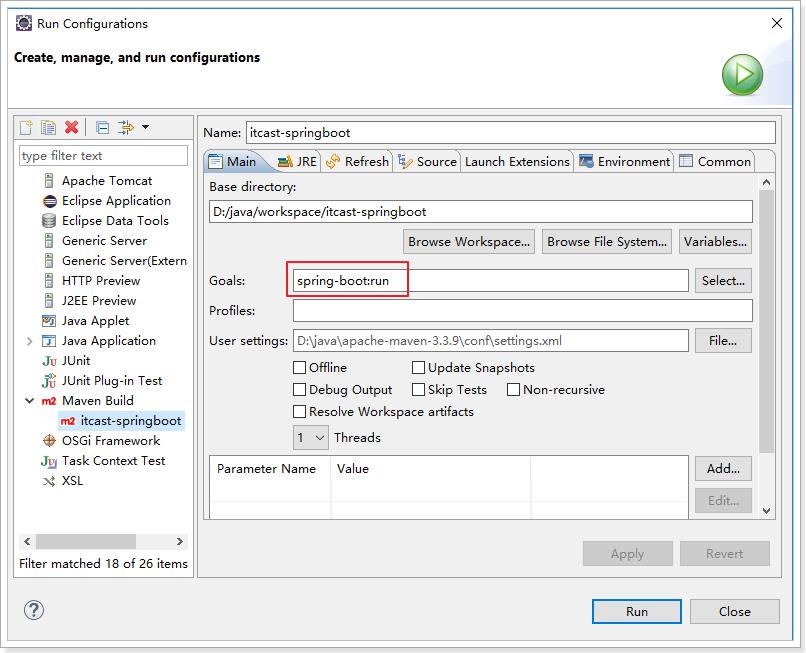
启动效果:

看到如下信息就说明启动成功了:
INFO 6188 --- [ main] c.i.springboot.demo.HelloApplication : Started HelloApplication in 3.281 seconds (JVM running for 3.601)
1.3.6. 测试
打开浏览器,输入地址:
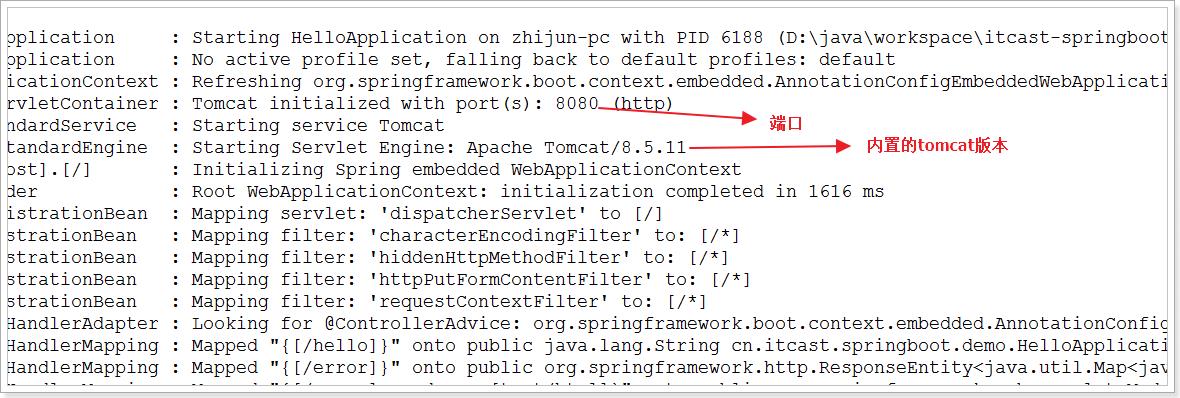
效果:

1.4. Spring Boot的核心
1.4.1. 入口类和@SpringBootApplication
Spring Boot的项目一般都会有*Application的入口类,入口类中会有main方法,这是一个标准的Java应用程序的入口方法。
@SpringBootApplication注解是Spring Boot的核心注解,它其实是一个组合注解:

该注解主要组合了以下注解:
- @SpringBootConfiguration:这是Spring Boot项目的配置注解,这也是一个组合注解:
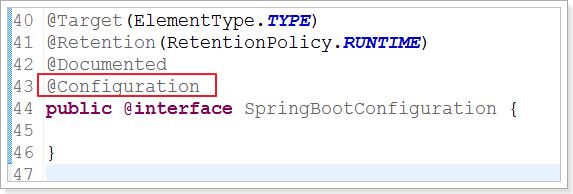
- 在Spring Boot项目中推荐使用@ SpringBootConfiguration替代@Configuration
- @EnableAutoConfiguration:启用自动配置,该注解会使Spring Boot根据项目中依赖的jar包自动配置项目的配置项:
a) 如:我们添加了spring-boot-starter-web的依赖,项目中也就会引入SpringMVC的依赖,Spring Boot就会自动配置tomcat和SpringMVC
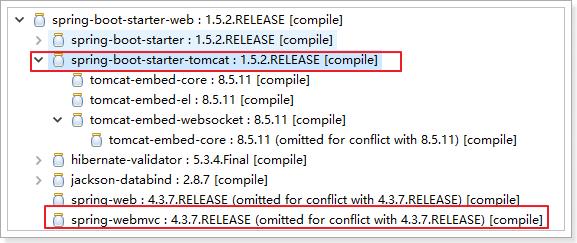
4,@ComponentScan:默认扫描@SpringBootApplication所在类的同级目录以及它的子目录。
1.4.2. 关闭自动配置
通过上述,我们得知,Spring Boot会根据项目中的jar包依赖,自动做出配置,Spring Boot支持的自动配置如下(非常多):
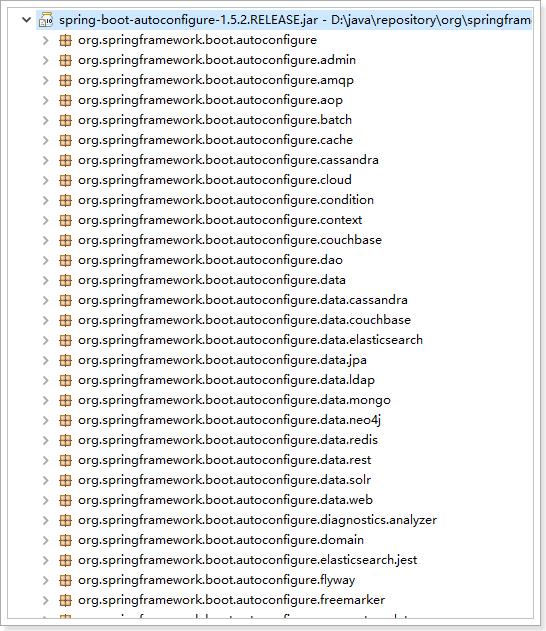
如果我们不需要Spring Boot自动配置,想关闭某一项的自动配置,该如何设置呢?
比如:我们不想自动配置Redis,想手动配置。

当然了,其他的配置就类似了。
1.4.3. 自定义Banner
启动Spring Boot项目后会看到这样的图案:

这个图片其实是可以自定义的:
- 打开网站:http://patorjk.com/software/taag/#p=display&h=3&v=3&f=4Max&t=itcast%20Spring%20Boot
- 拷贝生成的字符到一个文本文件中,并且将该文件命名为banner.txt
- 将banner.txt拷贝到项目的resources目录中:
- 重新启动程序,查看效果:
如果不想看到任何的banner,也是可以将其关闭的:

1.4.4. 全局配置文件
Spring Boot项目使用一个全局的配置文件application.properties或者是application.yml,在resources目录下或者类路径下的/config下,一般我们放到resources下。
1、 修改tomcat的端口为8088
重新启动应用,查看效果:

2、 修改进入DispatcherServlet的规则为:*.html
测试:
更多的配置:
# ===================================================================
# COMMON SPRING BOOT PROPERTIES
#
# This sample file is provided as a guideline. Do NOT copy it in its
# entirety to your own application. ^^^
# ===================================================================
# ----------------------------------------
# CORE PROPERTIES
# ----------------------------------------
# BANNER
banner.charset=UTF-8 # Banner file encoding.
banner.location=classpath:banner.txt # Banner file location.
banner.image.location=classpath:banner.gif # Banner image file location (jpg/png can also be used).
banner.image.width= # Width of the banner image in chars (default 76)
banner.image.height= # Height of the banner image in chars (default based on image height)
banner.image.margin= # Left hand image margin in chars (default 2)
banner.image.invert= # If images should be inverted for dark terminal themes (default false)
# LOGGING
logging.config= # Location of the logging configuration file. For instance `classpath:logback.xml` for Logback
logging.exception-conversion-word=%wEx # Conversion word used when logging exceptions.
logging.file= # Log file name. For instance `myapp.log`
logging.level.*= # Log levels severity mapping. For instance `logging.level.org.springframework=DEBUG`
logging.path= # Location of the log file. For instance `/var/log`
logging.pattern.console= # Appender pattern for output to the console. Only supported with the default logback setup.
logging.pattern.file= # Appender pattern for output to the file. Only supported with the default logback setup.
logging.pattern.level= # Appender pattern for log level (default %5p). Only supported with the default logback setup.
logging.register-shutdown-hook=false # Register a shutdown hook for the logging system when it is initialized.
# AOP
spring.aop.auto=true # Add @EnableAspectJAutoProxy.
spring.aop.proxy-target-class=false # Whether subclass-based (CGLIB) proxies are to be created (true) as opposed to standard Java interface-based proxies (false).
# IDENTITY (ContextIdApplicationContextInitializer)
spring.application.index= # Application index.
spring.application.name= # Application name.
# ADMIN (SpringApplicationAdminJmxAutoConfiguration)
spring.application.admin.enabled=false # Enable admin features for the application.
spring.application.admin.jmx-name=org.springframework.boot:type=Admin,name=SpringApplication # JMX name of the application admin MBean.
# AUTO-CONFIGURATION
spring.autoconfigure.exclude= # Auto-configuration classes to exclude.
# SPRING CORE
spring.beaninfo.ignore=true # Skip search of BeanInfo classes.
# SPRING CACHE (CacheProperties)
spring.cache.cache-names= # Comma-separated list of cache names to create if supported by the underlying cache manager.
spring.cache.caffeine.spec= # The spec to use to create caches. Check CaffeineSpec for more details on the spec format.
spring.cache.couchbase.expiration=0 # Entry expiration in milliseconds. By default the entries never expire.
spring.cache.ehcache.config= # The location of the configuration file to use to initialize EhCache.
spring.cache.guava.spec= # The spec to use to create caches. Check CacheBuilderSpec for more details on the spec format.
spring.cache.infinispan.config= # The location of the configuration file to use to initialize Infinispan.
spring.cache.jcache.config= # The location of the configuration file to use to initialize the cache manager.
spring.cache.jcache.provider= # Fully qualified name of the CachingProvider implementation to use to retrieve the JSR-107 compliant cache manager. Only needed if more than one JSR-107 implementation is available on the classpath.
spring.cache.type= # Cache type, auto-detected according to the environment by default.
# SPRING CONFIG - using environment property only (ConfigFileApplicationListener)
spring.config.location= # Config file locations.
spring.config.name=application # Config file name.
# HAZELCAST (HazelcastProperties)
spring.hazelcast.config= # The location of the configuration file to use to initialize Hazelcast.
# PROJECT INFORMATION (ProjectInfoProperties)
spring.info.build.location=classpath:META-INF/build-info.properties # Location of the generated build-info.properties file.
spring.info.git.location=classpath:git.properties # Location of the generated git.properties file.
# JMX
spring.jmx.default-domain= # JMX domain name.
spring.jmx.enabled=true # Expose management beans to the JMX domain.
spring.jmx.server=mbeanServer # MBeanServer bean name.
# Email (MailProperties)
spring.mail.default-encoding=UTF-8 # Default MimeMessage encoding.
spring.mail.host= # SMTP server host. For instance `smtp.example.com`
spring.mail.jndi-name= # Session JNDI name. When set, takes precedence to others mail settings.
spring.mail.password= # Login password of the SMTP server.
spring.mail.port= # SMTP server port.
spring.mail.properties.*= # Additional JavaMail session properties.
spring.mail.protocol=smtp # Protocol used by the SMTP server.
spring.mail.test-connection=false # Test that the mail server is available on startup.
spring.mail.username= # Login user of the SMTP server.
# APPLICATION SETTINGS (SpringApplication)
spring.main.banner-mode=console # Mode used to display the banner when the application runs.
spring.main.sources= # Sources (class name, package name or XML resource location) to include in the ApplicationContext.
spring.main.web-environment= # Run the application in a web environment (auto-detected by default).
# FILE ENCODING (FileEncodingApplicationListener)
spring.mandatory-file-encoding= # Expected character encoding the application must use.
# INTERNATIONALIZATION (MessageSourceAutoConfiguration)
spring.messages.always-use-message-format=false # Set whether to always apply the MessageFormat rules, parsing even messages without arguments.
spring.messages.basename=messages # Comma-separated list of basenames, each following the ResourceBundle convention.
spring.messages.cache-seconds=-1 # Loaded resource bundle files cache expiration, in seconds. When set to -1, bundles are cached forever.
spring.messages.encoding=UTF-8 # Message bundles encoding.
spring.messages.fallback-to-system-locale=true # Set whether to fall back to the system Locale if no files for a specific Locale have been found.
# OUTPUT
spring.output.ansi.enabled=detect # Configure the ANSI output.
# PID FILE (ApplicationPidFileWriter)
spring.pid.fail-on-write-error= # Fail if ApplicationPidFileWriter is used but it cannot write the PID file.
spring.pid.file= # Location of the PID file to write (if ApplicationPidFileWriter is used).
# PROFILES
spring.profiles.active= # Comma-separated list (or list if using YAML) of active profiles.
spring.profiles.include= # Unconditionally activate the specified comma separated profiles (or list of profiles if using YAML).
# SENDGRID (SendGridAutoConfiguration)
spring.sendgrid.api-key= # SendGrid api key (alternative to username/password)
spring.sendgrid.username= # SendGrid account username
spring.sendgrid.password= # SendGrid account password
spring.sendgrid.proxy.host= # SendGrid proxy host
spring.sendgrid.proxy.port= # SendGrid proxy port
# ----------------------------------------
# WEB PROPERTIES
# ----------------------------------------
# EMBEDDED SERVER CONFIGURATION (ServerProperties)
server.address= # Network address to which the server should bind to.
server.compression.enabled=false # If response compression is enabled.
server.compression.excluded-user-agents= # List of user-agents to exclude from compression.
server.compression.mime-types= # Comma-separated list of MIME types that should be compressed. For instance `text/html,text/css,application/json`
server.compression.min-response-size= # Minimum response size that is required for compression to be performed. For instance 2048
server.connection-timeout= # Time in milliseconds that connectors will wait for another HTTP request before closing the connection. When not set, the connector\'s container-specific default will be used. Use a value of -1 to indicate no (i.e. infinite) timeout.
server.context-parameters.*= # Servlet context init parameters. For instance `server.context-parameters.a=alpha`
server.context-path= # Context path of the application.
server.display-name=application # Display name of the application.
server.max-http-header-size=0 # Maximum size in bytes of the HTTP message header.
server.error.include-stacktrace=never # When to include a "stacktrace" attribute.
server.error.path=/error # Path of the error controller.
server.error.whitelabel.enabled=true # Enable the default error page displayed in browsers in case of a server error.
server.jetty.acceptors= # Number of acceptor threads to use.
server.jetty.max-http-post-size=0 # Maximum size in bytes of the HTTP post or put content.
server.jetty.selectors= # Number of selector threads to use.
server.jsp-servlet.class-name=org.apache.jasper.servlet.JspServlet # The class name of the JSP servlet.
server.jsp-servlet.init-parameters.*= # Init parameters used to configure the JSP servlet
server.jsp-servlet.registered=true # Whether or not the JSP servlet is registered
server.port=8080 # Server HTTP port.
server.server-header= # Value to use for the Server response header (no header is sent if empty)
server.servlet-path=/ # Path of the main dispatcher servlet.
server.use-forward-headers= # If X-Forwarded-* headers should be applied to the HttpRequest.
server.session.cookie.comment= # Comment for the session cookie.
server.session.cookie.domain= # Domain for the session cookie.
server.session.cookie.http-only= # "HttpOnly" flag for the session cookie.
server.session.cookie.max-age= # Maximum age of the session cookie in seconds.
server.session.cookie.name= # Session cookie name.
server.session.cookie.path= # Path of the session cookie.
server.session.cookie.secure= # "Secure" flag for the session cookie.
server.session.persistent=false # Persist session data between restarts.
server.session.store-dir= # Directory used to store session data.
server.session.timeout= # Session timeout in seconds.
server.session.tracking-modes= # Session tracking modes (one or more of the following: "cookie", "url", "ssl").
server.ssl.ciphers= # Supported SSL ciphers.
server.ssl.client-auth= # Whether client authentication is wanted ("want") or needed ("need"). Requires a trust store.
server.ssl.enabled= # Enable SSL support.
server.ssl.enabled-protocols= # Enabled SSL protocols.
server.ssl.key-alias= # Alias that identifies the key in the key store.
server.ssl.key-password= # Password used to access the key in the key store.
server.ssl.key-store= # Path to the key store that holds the SSL certificate (typically a jks file).
server.ssl.key-store-password= # Password used to access the key store.
server.ssl.key-store-provider= # Provider for the key store.
server.ssl.key-store-type= # Type of the key store.
server.ssl.protocol=TLS # SSL protocol to use.
server.ssl.trust-store= # Trust store that holds SSL certificates.
server.ssl.trust-store-password= # Password used to access the trust store.
server.ssl.trust-store-provider= # Provider for the trust store.
server.ssl.trust-store-type= # Type of the trust store.
server.tomcat.accept-count= # Maximum queue length for incoming connection requests when all possible request processing threads are in use.
server.tomcat.accesslog.buffered=true # Buffer output such that it is only flushed periodically.
server.tomcat.accesslog.directory=logs # Directory in which log files are created. Can be relative to the tomcat base dir or absolute.
server.tomcat.accesslog.enabled=false # Enable access log.
server.tomcat.accesslog.pattern=common # Format pattern for access logs.
server.tomcat.accesslog.prefix=access_log # Log file name prefix.
server.tomcat.accesslog.rename-on-rotate=false # Defer inclusion of the date stamp in the file name until rotate time.
server.tomcat.accesslog.request-attributes-enabled=false # Set request attributes for IP address, Hostname, protocol and port used for the request.
server.tomcat.accesslog.rotate=true # Enable access log rotation.
server.tomcat.accesslog.suffix=.log # Log file name suffix.
server.tomcat.additional-tld-skip-patterns= # Comma-separated list of additional patterns that match jars to ignore for TLD scanning.
server.tomcat.background-processor-delay=30 # Delay in seconds between the invocation of backgroundProcess methods.
server.tomcat.basedir= # Tomcat base directory. If not specified a temporary directory will be used.
server.tomcat.internal-proxies=10\\\\.\\\\d{1,3}\\\\.\\\\d{1,3}\\\\.\\\\d{1,3}|\\\\
192\\\\.168\\\\.\\\\d{1,3}\\\\.\\\\d{1,3}|\\\\
169\\\\.254\\\\.\\\\d{1,3}\\\\.\\\\d{1,3}|\\\\
127\\\\.\\\\d{1,3}\\\\.\\\\d{1,3}\\\\.\\\\d{1,3}|\\\\
172\\\\.1[6-9]{1}\\\\.\\\\d{1,3}\\\\.\\\\d{1,3}|\\\\
172\\\\.2[0-9]{1}\\\\.\\\\d{1,3}\\\\.\\\\d{1,3}|\\\\
172\\\\.3[0-1]{1}\\\\.\\\\d{1,3}\\\\.\\\\d{1,3} # regular expression matching trusted IP addresses.
server.tomcat.max-connections= # Maximum number of connections that the server will accept and process at any given time.
server.tomcat.max-http-post-size=0 # Maximum size in bytes of the HTTP post content.
server.tomcat.max-threads=0 # Maximum amount of worker threads.
server.tomcat.min-spare-threads=0 # Minimum amount of worker threads.
server.tomcat.port-header=X-Forwarded-Port # Name of the HTTP header used to override the original port value.
server.tomcat.protocol-header= # Header that holds the incoming protocol, usually named "X-Forwarded-Proto".
server.tomcat.protocol-header-https-value=https # Value of the protocol header that indicates that the incoming request uses SSL.
server.tomcat.redirect-context-root= # Whether requests to the context root should be redirected by appending a / to the path.
server.tomcat.remote-ip-header= # Name of the http header from which the remote ip is extracted. For instance `X-FORWARDED-FOR`
server.tomcat.uri-encoding=UTF-8 # Character encoding to use to decode the URI.
server.undertow.accesslog.dir= # Undertow access log directory.
server.undertow.accesslog.enabled=false # Enable access log.
server.undertow.accesslog.pattern=common # Format pattern for access logs.
server.undertow.accesslog.prefix=access_log. # Log file name prefix.
server.undertow.accesslog.rotate=true # Enable access log rotation.
server.undertow.accesslog.suffix=log # Log file name suffix.
server.undertow.buffer-size= # Size of each buffer in bytes.
server.undertow.buffers-per-region= # Number of buffer per region.
server.undertow.direct-buffers= # Allocate buffers outside the Java heap.
server.undertow.io-threads= # Number of I/O threads to create for the worker.
server.undertow.max-http-post-size=0 # Maximum size in bytes of the HTTP post content.
server.undertow.worker-threads= # Number of worker threads.
# FREEMARKER (FreeMarkerAutoConfiguration)
spring.freemarker.allow-request-override=false # Set whether HttpServletRequest attributes are allowed to override (hide) controller generated model attributes of the same name.
spring.freemarker.allow-session-override=false # Set whether HttpSession attributes are allowed to override (hide) controller generated model attributes of the same name.
spring.freemarker.cache=false # Enable template caching.
spring.freemarker.charset=UTF-8 # Template encoding.
spring.freemarker.check-template-location=true # Check that the templates location exists.
spring.freemarker.content-type=text/html # Content-Type value.
spring.freemarker.enabled=true # Enable MVC view resolution for this technology.
spring.freemarker.expose-request-attributes=false # Set whether all request attributes should be added to the model prior to merging with the template.
spring.freemarker.expose-session-attributes=false # Set whether all HttpSession attributes should be added to the model prior to merging with the template.
spring.freemarker.expose-spring-macro-helpers=true # Set whether to expose a RequestContext for use by Spring\'s macro library, under the name "springMacroRequestContext".
spring.freemarker.prefer-file-system-access=true # Prefer file system access for template loading. File system access enables hot detection of template changes.
spring.freemarker.prefix= # Prefix that gets prepended to view names when building a URL.
spring.freemarker.request-context-attribute= # Name of the RequestContext attribute for all views.
spring.freemarker.settings.*= # Well-known FreeMarker keys which will be passed to FreeMarker\'s Configuration.
spring.freemarker.suffix= # Suffix that gets appended to view names when building a URL.
spring.freemarker.template-loader-path=classpath:/templates/ # Comma-separated list of template paths.
spring.freemarker.view-names= # White list of view names that can be resolved.
# GROOVY TEMPLATES (GroovyTemplateAutoConfiguration)
spring.groovy.template.allow-request-override=false # Set whether HttpServletRequest attributes are allowed to override (hide) controller generated model attributes of the same name.
spring.groovy.template.allow-session-override=false # Set whether HttpSession attributes are allowed to override (hide) controller generated model attributes of the same name.
spring.groovy.template.cache= # Enable template caching.
spring.groovy.template.charset=UTF-8 # Template encoding.
spring.groovy.template.check-template-location=true # Check that the templates location exists.
spring.groovy.template.configuration.*= # See GroovyMarkupConfigurer
spring.groovy.template.content-type=test/html # Content-Type value.
spring.groovy.template.enabled=true # Enable MVC view resolution for this technology.
spring.groovy.template.expose-request-attributes=false # Set whether all request attributes should be added to the model prior to merging with the template.
spring.groovy.template.expose-session-attributes=false # Set whether all HttpSession attributes should be added to the model prior to merging with the template.
spring.groovy.template.expose-spring-macro-helpers=true # Set whether to expose a RequestContext for use by Spring\'s macro library, under the name "springMacroRequestContext".
spring.groovy.template.prefix= # Prefix that gets prepended to view names when building a URL.
spring.groovy.template.request-context-attribute= # Name of the RequestContext attribute for all views.
spring.groovy.template.resource-loader-path=classpath:/templates/ # Template path.
spring.groovy.template.suffix=.tpl # Suffix that gets appended to view names when building a URL.
spring.groovy.template.view-names= # White list of view names that can be resolved.
# SPRING HATEOAS (HateoasProperties)
spring.hateoas.use-hal-as-default-json-media-type=true # Specify if application/hal+json responses should be sent to requests that accept application/json.
# HTTP message conversion
spring.http.converters.preferred-json-mapper=jackson # Preferred JSON mapper to use for HTTP message conversion. Set to "gson" to force the use of Gson when both it and Jackson are on the classpath.
# HTTP encoding (HttpEncodingProperties)
spring.http.encoding.charset=UTF-8 # Charset of HTTP requests and responses. Added to the "Content-Type" header if not set explicitly.
spring.http.encoding.enabled=true # Enable http encoding support.
spring.http.encoding.force= # Force the encoding to the configured charset on HTTP requests and responses.
spring.http.encoding.force-request= # Force the encoding to the configured charset on HTTP requests. Defaults to true when "force" has not been specified.
spring.http.encoding.force-response= # Force the encoding to the configured charset on HTTP responses.
spring.http.encoding.mapping= # Locale to Encoding mapping.
# MULTIPART (MultipartProperties)
spring.http.multipart.enabled=true # Enable support of multi-part uploads.
spring.http.multipart.file-size-threshold=0 # Threshold after which files will be written to disk. Values can use the suffixed "MB" or "KB" to indicate a Megabyte or Kilobyte size.
spring.http.multipart.location= # Intermediate location of uploaded files.
spring.http.multipart.max-file-size=1MB # Max file size. Values can use the suffixed "MB" or "KB" to indicate a Megabyte or Kilobyte size.
spring.http.multipart.max-request-size=10MB # Max request size. Values can use the suffixed "MB" or "KB" to indicate a Megabyte or Kilobyte size.
spring.http.multipart.resolve-lazily=false # Whether to resolve the multipart request lazily at the time of file or parameter access.
# JACKSON (JacksonProperties)
spring.jackson.date-format= # Date format string or a fully-qualified date format class name. For instance `yyyy-MM-dd HH:mm:ss`.
spring.jackson.default-property-inclusion= # Controls the inclusion of properties during serialization.
spring.jackson.deserialization.*= # Jackson on/off features that affect the way Java objects are deserialized.
spring.jackson.generator.*= # Jackson on/off features for generators.
spring.jackson.joda-date-time-format= # Joda date time format string. If not configured, "date-format" will be used as a fallback if it is configured with a format string.
spring.jackson.locale= # Locale used for formatting.
spring.jackson.mapper.*= # Jackson general purpose on/off features.
spring.jackson.parser.*= # Jackson on/off features for parsers.
spring.jackson.property-naming-strategy= # One of the constants on Jackson\'s PropertyNamingStrategy. Can also be a fully-qualified class name of a PropertyNamingStrategy subclass.
spring.jackson.serialization.*= # Jackson on/off features that affect the way Java objects are serialized.
spring.jackson.time-zone= # Time zone used when formatting dates. For instance `America/Los_Angeles`
# JERSEY (JerseyProperties)
spring.jersey.application-path= # Path that serves as the base URI for the application. Overrides the value of "@ApplicationPath" if specified.
spring.jersey.filter.order=0 # Jersey filter chain order.
spring.jersey.init.*= # Init parameters to pass to Jersey via the servlet or filter.
spring.jersey.servlet.load-on-startup=-1 # Load on startup priority of the Jersey servlet.
spring.jersey.type=servlet # Jersey integration type.
# SPRING LDAP (LdapProperties)
spring.ldap.urls= # LDAP URLs of the server.
spring.ldap.base= # Base suffix from which all operations should originate.
spring.ldap.username= # Login user of the server.
spring.ldap.password= # Login password of the server.
spring.ldap.base-environment.*= # LDAP specification settings.
# EMBEDDED LDAP (EmbeddedLdapProperties)
spring.ldap.embedded.base-dn= # The base DN
spring.ldap.embedded.credential.username= # Embedded LDAP username.
spring.ldap.embedded.credential.password= # Embedded LDAP password.
spring.ldap.embedded.ldif=classpath:schema.ldif # Schema (LDIF) script resource reference.
spring.ldap.embedded.port= # Embedded LDAP port.
spring.ldap.embedded.validation.enabled=true # Enable LDAP schema validation.
spring.ldap.embedded.validation.schema= # Path to the custom schema.
# SPRING MOBILE DEVICE VIEWS (DeviceDelegatingViewResolverAutoConfiguration)
spring.mobile.devicedelegatingviewresolver.enable-fallback=false # Enable support for fallback resolution.
spring.mobile.devicedelegatingviewresolver.enabled=false # Enable device view resolver.
spring.mobile.devicedelegatingviewresolver.mobile-prefix=mobile/ # Prefix that gets prepended to view names for mobile devices.
spring.mobile.devicedelegatingviewresolver.mobile-suffix= # Suffix that gets appended to view names for mobile devices.
spring.mobile.devicedelegatingviewresolver.normal-prefix= # Prefix that gets prepended to view names for normal devices.
spring.mobile.devicedelegatingviewresolver.normal-suffix= # Suffix that gets appended to view names for normal devices.
spring.mobile.devicedelegatingviewresolver.tablet-prefix=tablet/ # Prefix that gets prepended to view names for tablet devices.
spring.mobile.devicedelegatingviewresolver.tablet-suffix= # Suffix that gets appended to view names for tablet devices.
# SPRING MOBILE SITE PREFERENCE (SitePreferenceAutoConfiguration)
spring.mobile.sitepreference.enabled=true # Enable SitePreferenceHandler.
# MUSTACHE TEMPLATES (MustacheAutoConfiguration)
spring.mustache.allow-request-override= # Set whether HttpServletRequest attributes are allowed to override (hide) controller generated model attributes of the same name.
spring.mustache.allow-session-override= # Set whether HttpSession attributes are allowed to override (hide) controller generated model attributes of the same name.
spring.mustache.cache= # Enable template caching.
spring.mustache.charset= # Template encoding.
spring.mustache.check-template-location= # Check that the templates location exists.
spring.mustache.content-type= # Content-Type value.
spring.mustache.enabled= # Enable MVC view resolution for this technology.
spring.mustache.expose-request-attributes= # Set whether all request attributes should be added to the model prior to merging with the template.
spring.mustache.expose-session-attributes= # Set whether all HttpSession attributes should be added to the model prior to merging with the template.
spring.mustache.expose-spring-macro-helpers= # Set whether to expose a RequestContext for use by Spring\'s macro library, under the name "springMacroRequestContext".
spring.mustache.prefix=classpath:/templates/ # Prefix to apply to template names.
spring.mustache.request-context-attribute= # Name of the RequestContext attribute for all views.
spring.mustache.suffix=.html # Suffix to apply to template names.
spring.mustache.view-names= # White list of view names that can be resolved.
# SPRING MVC (WebMvcProperties)
spring.mvc.async.request-timeout= # Amount of time (in milliseconds) before asynchronous request handling times out.
spring.mvc.date-format= # Date format to use. For instance `dd/MM/yyyy`.
spring.mvc.dispatch-trace-request=false # Dispatch TRACE requests to the FrameworkServlet doService method.
spring.mvc.dispatch-options-request=true # Dispatch OPTIONS requests to the FrameworkServlet doService method.
spring.mvc.favicon.enabled=true # Enable resolution of favicon.ico.
spring.mvc.formcontent.putfilter.enabled=true # Enable Spring\'s HttpPutFormContentFilter.
spring.mvc.ignore-default-model-on-redirect=true # If the content of the "default" model should be ignored during redirect scenarios.
spring.mvc.locale= # Locale to use. By default, this locale is overridden by the "Accept-Language" header.
spring.mvc.locale-resolver=accept-header # Define how the locale should be resolved.
spring.mvc.log-resolved-exception=false # Enable warn logging of exceptions resolved by a "HandlerExceptionResolver".
spring.mvc.media-types.*= # Maps file extensions to media types for content negotiation.
spring.mvc.message-codes-resolver-format= # Formatting strategy for message codes. For instance `PREFIX_ERROR_CODE`.
spring.mvc.servlet.load-on-startup=-1 # Load on startup priority of the Spring Web Services servlet.
spring.mvc.static-path-pattern=/** # Path pattern used for static resources.
spring.mvc.throw-exception-if-no-handler-found=false # If a "NoHandlerFoundException" should be thrown if no Handler was found to process a request.
spring.mvc.view.prefix= # Spring MVC view prefix.
spring.mvc.view.suffix= # Spring MVC view suffix.
# SPRING RESOURCES HANDLING (ResourceProperties)
spring.resources.add-mappings=true # Enable default resource handling.
spring.resources.cache-period= # Cache period for the resources served by the resource handler, in seconds.
spring.resources.chain.cache=true # Enable caching in the Resource chain.
spring.resources.chain.enabled= # Enable the Spring Resource Handling chain. Disabled by default unless at least one strategy has been enabled.
spring.resources.chain.gzipped=false # Enable resolution of already gzipped resources.
spring.resources.chain.html-application-cache=false # Enable HTML5 application cache manifest rewriting.
spring.resources.chain.strategy.content.enabled=false # Enable the content Version Strategy.
spring.resources.chain.strategy.content.paths=/** # Comma-separated list of patterns to apply to the Version Strategy.
spring.resources.chain.strategy.fixed.enabled=false # Enable the fixed Version Strategy.
spring.resources.chain.strategy.fixed.paths=/** # Comma-separated list of patterns to apply to the Version Strategy.
spring.resources.chain.strategy.fixed.version= # Version string to use for the Version Strategy.
spring.resources.static-locations=classpath:/META-INF/resources/,classpath:/resources/,classpath:/static/,classpath:/public/ # Locations of static resources.
# SPRING SESSION (SessionProperties)
spring.session.hazelcast.flush-mode=on-save # Sessions flush mode.
spring.session.hazelcast.map-name=spring:session:sessions # Name of the map used to store sessions.
spring.session.jdbc.initializer.enabled= # Create the required session tables on startup if necessary. Enabled automatically if the default table name is set or a custom schema is configured.
spring.session.jdbc.schema=classpath:org/springframework/session/jdbc/schema-@@platform@@.sql # Path to the SQL file to use to initialize the database schema.
spring.session.jdbc.table-name=SPRING_SESSION # Name of database table used to store sessions.
spring.session.mongo.collection-name=sessions # Collection name used to store sessions.
spring.session.redis.flush-mode=on-save # Sessions flush mode.
spring.session.redis.namespace= # Namespace for keys used to store sessions.
spring.session.store-type= # Session store type.
# SPRING SOCIAL (SocialWebAutoConfiguration)
spring.social.auto-connection-views=false # Enable the connection status view for supported providers.
# SPRING SOCIAL FACEBOOK (FacebookAutoConfiguration)
spring.social.facebook.app-id= # your application\'s Facebook App ID
spring.social.facebook.app-secret= # your application\'s Facebook App Secret
# SPRING SOCIAL LINKEDIN (LinkedInAutoConfiguration)
spring.social.linkedin.app-id= # your application\'s LinkedIn App ID
spring.social.linkedin.app-secret= # your application\'s LinkedIn App Secret
# SPRING SOCIAL TWITTER (TwitterAutoConfiguration)
spring.social.twitter.app-id= # your application\'s Twitter App ID
spring.social.twitter.app-secret= # your application\'s Twitter App Secret
# THYMELEAF (ThymeleafAutoConfiguration)
spring.thymeleaf.cache=true # Enable template caching.
spring.thymeleaf.check-template=true # Check that the template exists before rendering it.
spring.thymeleaf.check-template-location=true # Check that the templates location exists.
spring.thymeleaf.content-type=text/html # Content-Type value.
spring.thymeleaf.enabled=true # Enable MVC Thymeleaf view resolution.
spring.thymeleaf.encoding=UTF-8 # Template encoding.
spring.thymeleaf.excluded-view-names= # Comma-separated list of view names that should be excluded from resolution.
spring.thymeleaf.mode=HTML5 # Template mode to be applied to templates. See also StandardTemplateModeHandlers.
spring.thymeleaf.prefix=classpath:/templates/ # Prefix that gets prepended to view names when building a URL.
spring.thymeleaf.suffix=.html # Suffix that gets appended to view names when building a URL.
spring.thymeleaf.template-resolver-order= # Order of the template resolver in the chain.
spring.thymeleaf.view-names= # Comma-separated list of view names that can be resolved.
# SPRING WEB SERVICES (SpringBoot 学习笔记 -- [了解SpringBoot的基础知识,快速上手搭建一个简单案例]
211期Tomcat 在 SpringBoot 中是如何启动的?
springboot2 后台管理系统 springbootplus
SpringBoot:以最少的配置运行 Junit 单元测试